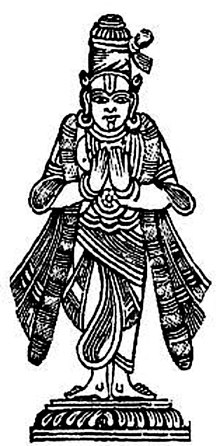Bhoothath Alvar | |
|---|---|
 | |
| Personal | |
| Born | 4203 BCE[1][2] |
| Religion | Hinduism |
| Organization | |
| Philosophy | Vaishnava Bhakti |
| Religious career | |
| Literary works | Irantam Tiruvantati |
| Honors | Alvar saint |
Bhoothath Alvar (Tamil: பூதத்தாழ்வார், romanized: Bhūtathāḻvār) is one of the twelve Alvar saints of South India, who were known for their affiliation to the Vaishnava tradition of Hinduism. The verses of Alvars are compiled as Nalayira Divya Prabandham and the 108 temples revered are classified as Divya Desams.[3] Bhoothath is considered second in the list of the three principal Alvars, with the other two being Poigai Alvar and Pey Alvar, collectively called Mutalamalvargal who are known to be born out of divinity. Bhoothath composed hundred verses that are classified as Irantam Tiruvantati and his composition is set in the antati style in which the ending syllable is the starting one for the next verse.
As per Hindu legend, Bhoothath was found in a liquorice flower in Thirukadalmallai (modern-day Mahabalipuram). The poet-saint is regarded to have borne such zeal for the Hindu god Vishnu that he was said to have been possessed by a ghost (Bhūta), where he received his epithet.
According to Sri Vaishnava legend, the three Alvars were once were confined in a small dark enclosure during a rain in Thirukovilur and they experienced a fourth individual among them. They found out that it was god Vishnu and Poigai wished to see his face continuously but could view only from the simmering light of the lightning. With a view to maintain the continuity of light, Poigai instantly composed hundred songs wishing light to emerge. Pey and Bhoothath continued composing hundred songs each on Vishnu. The works of these earliest saints contributed to the philosophical and theological ideas of Vaishnavism. Along with the three Shaiva Nayanmars, they influenced the ruling Pallava kings of the South Indian region, resulting in changing the religious geography from Buddhism and Jainism to the two sects of Hinduism.
- ^ L. Annapoorna (2000). Music and temples, a ritualistic approach. p. 23. ISBN 9788175740907.
- ^ Sakkottai Krishnaswami Aiyangar (1911). Ancient India: Collected Essays on the Literary and Political History of Southern India. pp. 403–404. ISBN 9788120618503.
- ^ Rao, P.V.L. Narasimha (2008). Kanchipuram – Land of Legends, Saints & Temples. New Delhi: Readworthy Publications (P) Ltd. p. 27. ISBN 978-93-5018-104-1.